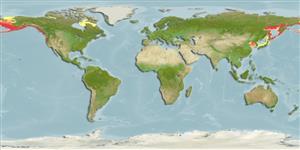Classification / Names
Common names from other countries
Main reference
Size / Weight / Age
Max length : 91.0 cm TL male/unsexed; (Ref. 2850); common length : 57.5 cm TL male/unsexed; (Ref. 12193); max. published weight: 9.1 kg (Ref. 2850); max. reported age: 24 years (Ref. 28499)
Length at first maturity
Lm ?, range 35 - ? cm
Environment
Marine; freshwater; brackish; demersal; catadromous (Ref. 51243); depth range 0 - 375 m (Ref. 6793)
Climate / Range
Polar, preferred 4°C (Ref. 107945); 70°N - 34°N
Distribution
North Pacific: Korea and southern Japan through the Bering Strait and Arctic Alaska (Ref. 2850) to the Coronation Gulf, Northwest Territories, Canada and Santa Barbara, southern California, USA. Hybridizes with Parophrys vetulus - the hybrid, called Inopsetta ischyra, may be found from the Bering Sea to San Francisco, California, USA. Also hybridizes with Kareius bicoloratus (Ref. 27547).
Countries | FAO areas | Ecosystems | Occurrences | Introductions
Short description
Dorsal
spines
(total): 0;
Dorsal
soft rays
(total): 52-66;
Anal
spines: 1;
Anal
soft rays: 38 - 47;
Vertebrae: 34 - 37. Distinguished by the presence of both eyes on the same side of the head, dorsal and anal fins that are marked with dark and light (white to orange) bars, and especially, by the stellate, bony tubercles scattered over its body (Ref. 27547). Dorsal originates over middle of upper eye; anal with a sharp, forward pointing spine (often buried in skin) before first ray; pectorals are bluntly pointed; caudal slightly rounded (Ref. 27547). Eyed side dark brown to nearly black, sometimes with indefinite blotchings (Alaskans specimens sometimes with a greenish tinge); blind side white to creamy; dorsal fin with 4 to 7 dark bars with white to orange spaces between; anal fin with 4 to 6 such bars; caudal fin with 3 or 4 dark longitudinal bars on its posterior part; in rare cases, the blind side may be partly or completely colored like the eyed side, or white may be present on the eyed side, creating a piebald effect (Ref. 27547, 28897, 28898).
IUCN Red List Status (Ref. 115185)
Threat to humans
Harmless
Human uses
Fisheries: commercial; gamefish: yes
Tools
Special reports
Download XML
Internet sources
Estimates of some properties based on models
Phylogenetic diversity index
PD50 = 0.7500 many relatives (e.g. carps) 0.5 - 2.0 few relatives (e.g. lungfishes)
Trophic Level
3.6 ±0.1 se; Based on diet studies.
Resilience
Medium, minimum population doubling time 1.4 - 4.4 years (tm=2-3; tmax=24)
Vulnerability
Moderate to high vulnerability (51 of 100)
Price category
